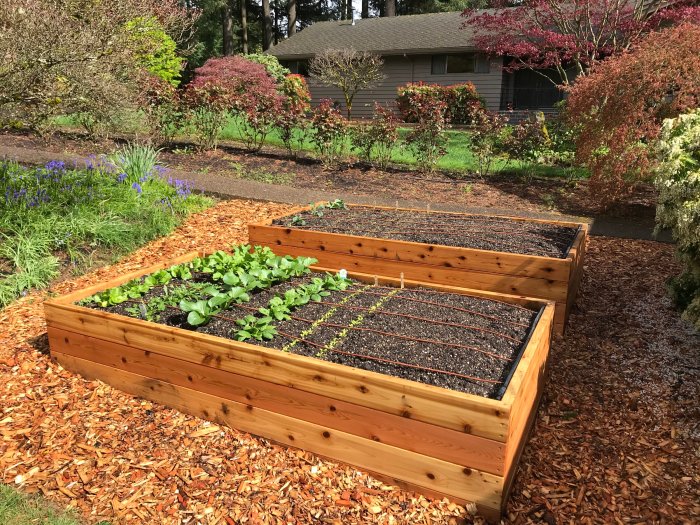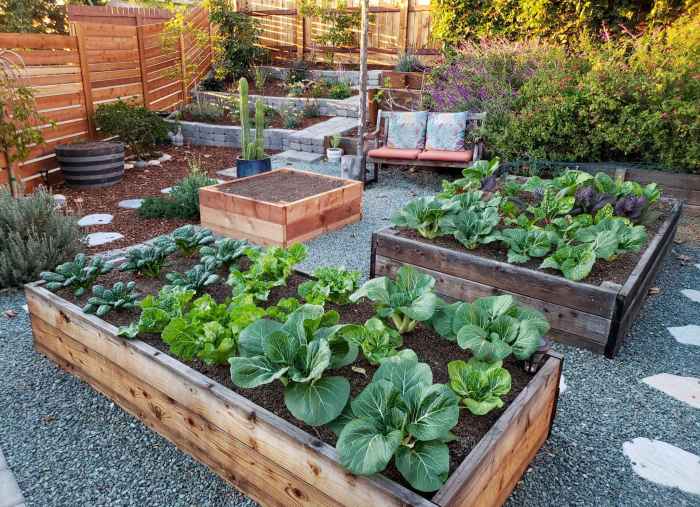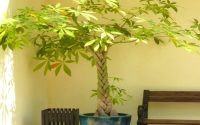Plant Tree in Raised Bed A Gardeners Guide
Planting the Tree in the Raised Bed: Plant Tree In Raised Bed

Plant tree in raised bed – Alright, so you’ve got your awesome raised bed, ready to rock, and your little tree sapling, lookin’ all cute and ready for its close-up. Planting it right is key to a thriving, majestic tree – think Beyoncé-level fabulous. We’re talking about giving that sapling the best shot at becoming a leafy legend.
Digging the perfect hole is like finding the sweet spot on a rollercoaster – you want that perfect balance of thrill and comfort. Too shallow, and your tree’s roots will be stressed. Too deep, and the trunk might rot. Get it just right, and you’re golden. We’re aiming for a planting hole that’s roughly twice as wide as the root ball and just as deep.
Think of it as giving your tree a spacious, comfy condo.
So, you’re digging that raised bed garden vibe, right? Perfect for keeping things tidy and your plants happy. If you’re looking for a pet-friendly option, consider a money tree – check out this article on money tree plant safe for cats to be sure. Then, pop that money tree (or other cat-safe plant!) in your raised bed, and you’re good to go, enjoying a lush, worry-free garden paradise.
Root Placement and Soil Compaction
Gently remove the tree from its container, trying not to disturb the roots too much. Imagine you’re handling a celebrity’s delicate hair – careful, careful! Loosen any circling roots – these are like a tree’s fashion faux pas, restricting growth. Spread those roots out like a starfish embracing the ocean (the soil, that is). Now, place the tree in the hole, making sure the top of the root ball is level with the surrounding soil.
Don’t bury the root flare – that’s the slightly swollen part at the base of the trunk. Think of it as the tree’s secret weapon against diseases, so keep it exposed. Backfill the hole with your awesome soil mix, gently firming it around the roots. Avoid compacting the soil too much, you don’t want to suffocate the roots.
Think of it as a light hug, not a bear hug. Water thoroughly after planting to settle the soil.
Ideal Planting Depth and Spacing
Picture this: Your tree is planted at the perfect depth, its roots happily spread out, not crammed like sardines in a can. The ideal planting depth ensures the root flare remains above the soil line. Spacing is equally crucial – avoid planting too close to other plants or structures. Imagine your tree as a rock star needing its own personal space to shine.
The required spacing varies depending on the mature size of the tree. Check the plant tag for recommendations or consult a gardening guide. For example, a small flowering cherry tree might need 10-15 feet of space, whereas a majestic oak could need significantly more. Think stadium seating versus a packed subway car.
Supporting the Newly Planted Tree
Especially in windy areas, providing support for your new tree is like giving it a bodyguard. A sturdy stake driven into the ground, but not too close to the trunk, and tied to the tree with a flexible material, will protect it from wind damage. Think of it as giving your tree a superhero cape, protecting it from the villainous winds.
Avoid using wire, as it can damage the trunk. You want a gentle guide, not a restrictive straitjacket. Remove the support once the tree is established and its roots are firmly anchored in the ground. This is usually after a year or two, depending on the tree’s growth rate and the climate.
Post-Planting Care and Maintenance

Okay, so you’ve successfully planted your little tree sapling – congrats! Now comes the fun part (and maybe a little bit of the stressful part), keeping it alive and thriving. Think of it like being a plant-parent – you’ve got to nurture it to help it reach its full potential. We’re talking about giving your tree the VIP treatment, ensuring it grows into a magnificent specimen that’ll make your neighbors green with envy (in a good way, of course!).Watering and fertilizing your new tree is crucial during its first year, kind of like making sure your new puppy gets enough food and water.
Neglecting this step is like forgetting to charge your phone before a big date – a recipe for disaster! Regular watering and feeding provide the essential nutrients and hydration needed for strong root development and overall growth. Think of it as giving your tree the ultimate power-up.
Watering Schedule for the First Year
A consistent watering schedule is key, especially during the first year. During dry spells, you’ll want to water deeply and less frequently rather than shallowly and often. Think of it as giving your tree a good, long drink rather than a series of sips. This encourages deep root growth, making your tree more resilient to drought conditions later on.
For example, a newly planted tree might need watering every other day during hot, dry periods, but less frequently during cooler, wetter times. Always check the soil moisture before watering – stick your finger a couple of inches into the soil; if it feels dry, it’s time to water.
Fertilizing Schedule for the First Year, Plant tree in raised bed
Now, let’s talk about feeding your little tree. A slow-release fertilizer is your best bet, especially during the first year. This type of fertilizer gradually releases nutrients into the soil, preventing nutrient burn and providing a steady supply of nourishment. Avoid over-fertilizing; it’s better to under-fertilize than to overdo it. Think of it as giving your tree a healthy multivitamin, not a whole box of sugary snacks.
A good rule of thumb is to follow the manufacturer’s instructions on the fertilizer packaging.
Addressing Common Challenges
Growing trees in raised beds presents some unique challenges. One common issue is pests and diseases. Regular inspection is your best defense. Look for signs of insect damage, leaf discoloration, or unusual growths. Early detection is key to effective treatment.
Think of it as regularly checking your car for any problems – it’s preventative maintenance. If you spot any problems, consult your local garden center or a professional arborist for advice on appropriate treatments. Organic pest control methods are often a good starting point, minimizing the environmental impact.Nutrient deficiencies can also be a problem, especially in raised beds where the soil volume is limited.
Regular soil testing can help identify any nutrient imbalances. Amending the soil with compost or other organic matter can improve soil fertility and provide a slow-release source of nutrients. Think of it as giving your tree a healthy dose of vitamins and minerals to boost its immune system. If testing reveals specific deficiencies, you can address them with targeted fertilizer applications.
Protecting the Young Tree from Harsh Weather
Harsh weather conditions, such as frost or strong winds, can seriously damage young trees. Protecting your tree from these elements is essential for its survival. For frost protection, consider wrapping the trunk with burlap or using a frost cloth to shield the tree from freezing temperatures. Think of it as wrapping your baby in a warm blanket on a cold night.
For wind protection, consider installing a windbreak or staking the tree to prevent it from being blown over. Imagine it like using a seatbelt for your tree to keep it safe and secure.
Query Resolution
Can I plant any type of tree in a raised bed?
No, it’s crucial to choose trees that will mature to a size appropriate for your raised bed and its structural integrity. Consider root systems to avoid damage.
How often should I water a newly planted tree in a raised bed?
Regular watering is key, especially during the first year. Aim for deep, infrequent watering rather than shallow, frequent watering to encourage deep root growth.
What kind of soil is best for a raised bed tree?
Well-draining soil rich in organic matter is ideal. Amend your soil with compost or other organic materials to improve its structure and fertility.
What if my raised bed tree gets diseased?
Monitor your tree regularly for signs of disease. Prompt action, such as removing affected branches or consulting a horticulturalist, is crucial to prevent widespread damage.



